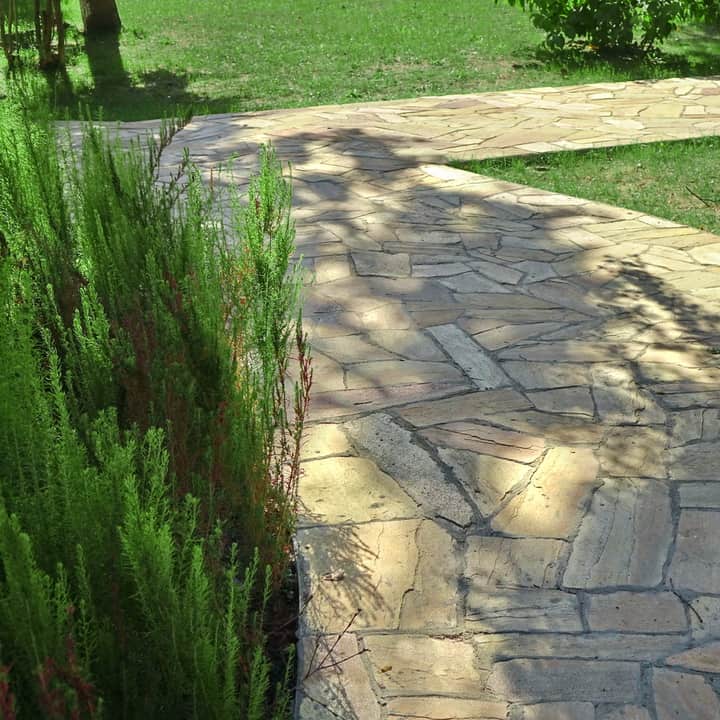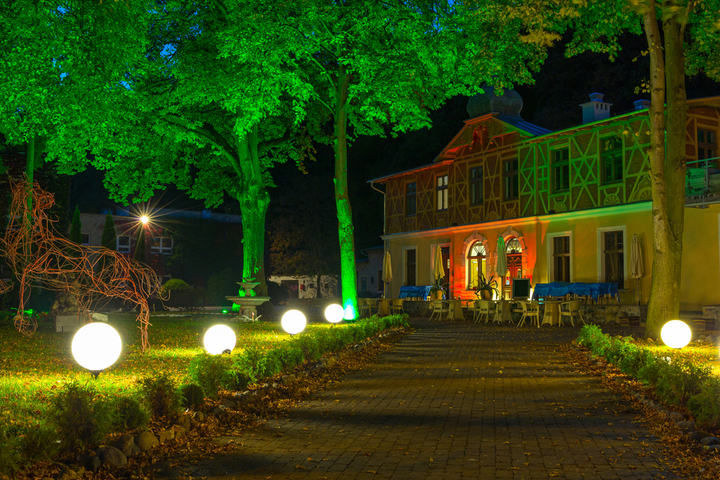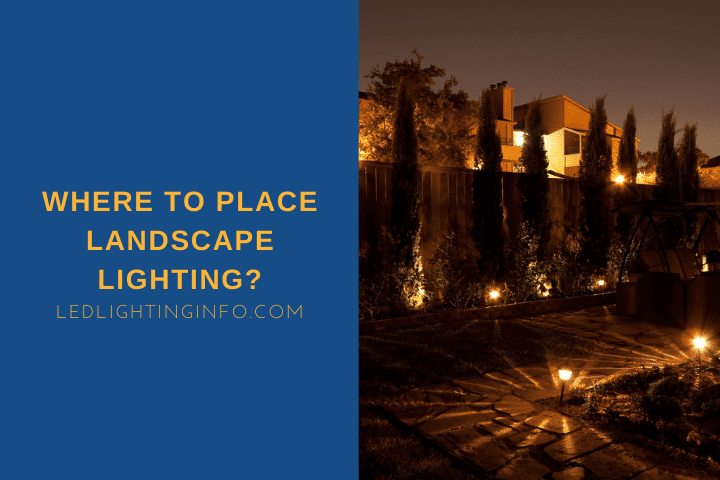So, you’ve decided to install landscape lighting in your outdoor space.
Great choice, but now comes the tricky part, working out the best place to put your lights and what kind of lights you’re going to need.
There’s a lot to think about, and it’ll depend on the kind of effect you’re looking for.
It’s not as simple as making your garden, patio, or driveway look brighter. There are a variety of subtle differences in lighting styles.
Landscape lighting should be carefully positioned to highlight landscape features, being mindful of the shadows being cast. Lights can illuminate or silhouette features for different effects. Pathway lighting should be close to the path, with 6-8 feet between each light for subtly.
There’s a lot to break down here, so let’s take a look at:
- Where garden lights should be positioned
- Whether it’s a good idea to install lights on a tree
- Where to place path lights
How Should I Position Garden Lights?

How you position your garden lights will depend completely on your outdoor space’s features.
You’ll want to make sure that you’ve illuminated every feature in some way, although there are different options available.
However, only illuminating some features will create an uneven space with darker, shadowy areas – it’ll look like the job’s half done.
Your priority should be to make sure any sitting areas are well-lit; otherwise, you can’t enjoy them properly.
If you have a patio or deck with furniture, make sure you add lamps around the space, either as downlighting on the wall of the house or as a stake or decking lights.
Space lights out every few feet – you don’t want it to be so bright that it hurts your eyes.
Gentle lighting is much preferred for relaxing in the evening in your outdoor space.
As for the rest of your garden, here are some of the options you can consider for your landscape lighting:
Highlighting

Highlighting is where you use lights to draw attention to a particular feature, whether that’s a tree, a shrub, or a statue.
It’s usually achieved with a spotlight, but it will depend on the size and shape of the feature you’re highlighting.
Trees will normally need at least two lights – one for the trunk and one for the leaves. Otherwise, it leaves the part of the tree looking like it’s floating.
Silhouetting
Silhouetting is where you place lights behind a feature.
It’s a more artistic choice that still helps to showcase your plants, but does so with striking crisp shadows instead of fully illuminating them.
Shadowing

Shadowing is where you choose lights that are positioned in a way to cast shadows. Still, instead of silhouetting, you’re trying to use dramatic shadows cast on another surface.
It’s a good idea if you have light-colored walls either around your garden or as part of your home and a tree that you can use to cast shadows onto the wall.
Otherwise the shadows can get lost.
Moonlighting
Moonlighting with regards to lighting just means using lights placed in an elevated position but shielded from full glare. Hence, the bulb itself isn’t usually visible.
It instead enhances the downward-facing light, as if you’ve given the moon a power boost.
If you have a pond, then it’s worth illuminating that too.
Waterproof lights placed around the sides of the pool, angled gently into the water, will help show the borders (for added safety) and look more appealing.
Don’t use completely horizontal lights, or it’ll reflect off the surface – lights should be aimed just below the water level.
Don’t worry about water and electricity too much for ponds here since your landscape lighting should be appropriately waterproofed anyway.
And as long as your pond is professionally built, it’ll have sealed edges, so there’s no risk of the water causing the ground to shift and the lights to move.
You can get underwater lights too, but these are better for highlighting features such as fountains.
The light will get lost if you’re trying to use them to safely show the borders.
Related: How To Set Landscape Lighting Timer?
Should I Install Lights On The Tree?

You can install lights on a tree if you want to, but you have to question whether that’s the best idea.
If you add a light to a tree, it will probably partially illuminate the tree, which will look strange.
If you want the tree to be seen, you want the whole thing to be visible.
This also makes the light the focal point of the tree, when you probably want that to be the tree itself.
If the tree is tall and you want to install downward-facing light from it, it’ll need to be close to another feature or your patio; otherwise, there’s no actual worth using it.
If you have a tree that overhangs your patio or maybe another cool feature, then go for it, but use a glare guard, so your eyes aren’t drawn to the shiny bulb above you.
Also read: Do Outdoor Lights Require GFCI?
How To Place Path Lights?

Illuminating your pathway is a great idea when planning your landscape lights.
It’s great for safety and for preventing you from accidentally treading on your prized flower bed when you’re returning home late at night.
You can buy dedicated pathway lights designed for the job, but where exactly should you position them?
Firstly, in terms of distance from the path, you’ll want them relatively close – within 6 inches.
The whole point is to illuminate the path edge, not what’s on either side of it, so by having them closer to the path border, you’ll get a better definition of the light.
For most people, it’s the edges only that matter. You don’t need the entire width of the pathway or driveway lit up. It’s normally a level surface.
So don’t think that you need to position the lights further away and at more of an angle to shine across the path.
Downward lighting is perfectly suitable.
Next, think about spacing – it’s best to place pavement lights between 6 and 8 feet apart. However, always check the instructions of the individual lights you choose.
Again, you’re only looking to highlight the pathway. You aren’t turning it into a fashion catwalk, so you don’t need lights every few inches.
As long as you get a clear view of the edges of the pathway, that’s all you’ll ever need. And subtly here looks better too.
One important note, though, is to make sure that outdoor staircases are illuminated differently from flat paths and driveways.
Pathways won’t cast shadows, but a staircase will, so you should treat them differently.
The priority here is to make sure the edge of each step is carefully lit, and larger lights work better to prevent ugly shadows.
Finally, think about how close to your home you want the lights to shine.
If you have a glass front door or a large window that faces where your landscape lighting will be, you might want to avoid having pathway lights too close.
Otherwise, you might get some unwanted light shining into your home.
Final Words
How you choose to light your garden will ultimately depend on your features.
Your priority is to illuminate any spaces you’re going to want to spend time in. For the rest of your garden, you should focus on noteworthy areas.
Trees, shrubs, and pools will all look great if you’re careful about how you light them.
Just make sure to always illuminate the entirety of a feature.
Whether that’s by choosing a wider-angled and brighter light or using more than one for particularly big elements like a tree, it looks much better than just seeing a trunk or ugly shadows on your fountain.
Any tips on landscape positioning? Reach out and let me know!

